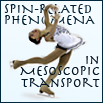Speaker
Alexander Khaetskii
Description
The phenomenon of edge spin accumulation, which appears due
to spin-orbit interaction in 2D mesoscopic structures in the
presence of a charge current, is considered. We consider
the case of a strong spin-orbit-related splitting of the
electron spectrum, i.e. a spin precession length is small
compared to the mean free path l. The structure can be
either in a ballistic regime (when the mean free path is the
largest scale in the problem) or quasiballistic regime
(when l is much smaller than the sample size). We showed
how physics of edge spin accumulation in different
situations should be understood from the point of view of
unitarity of boundary scattering. Using transparent method
of scattering states, we were able to explain some previous
puzzling theoretical results. In particular, we clarified
the important role of the form of the spin-orbit
Hamiltonian, the role of the boundary conditions, etc., and
revealed the wrong results obtained in this field. The
detailed comparison with the existing theoretical works is
presented. In particular, the relation between the edge spin
density and the bulk spin current in different regimes is
discussed. For example, for the cubic Hamiltonian the
"edge" contribution to the spin density can be larger than
the "bulk" one which appears as a result of the spin flux
from the bulk. This demands the reinterpretation of the
experimental results [1].
[1]. J. Wunderlich et al., PRL 94, 047204 (2005).
[1]. J. Wunderlich et al., PRL 94, 047204 (2005).

